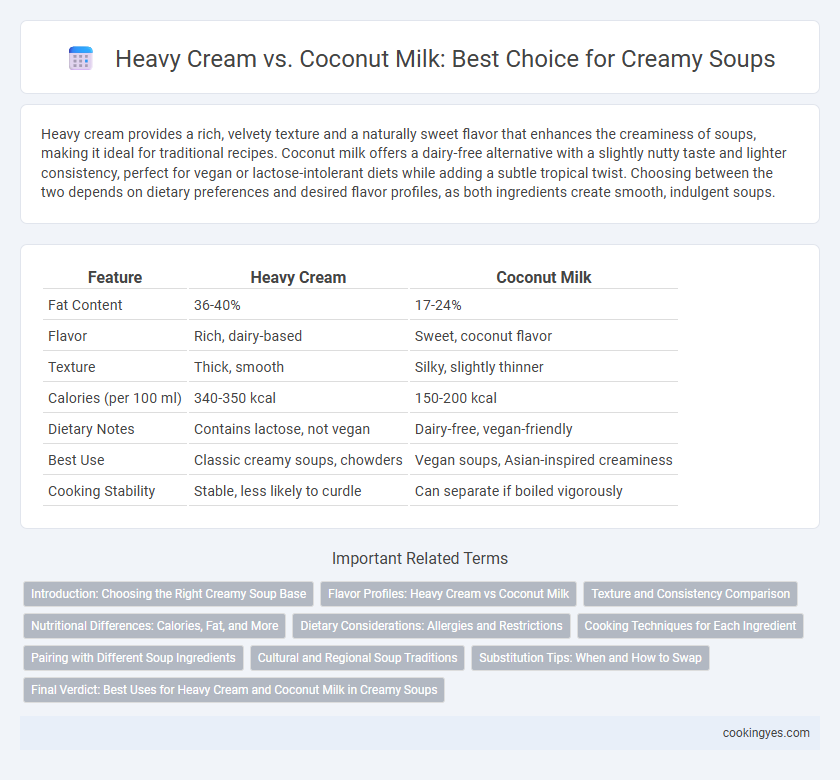Heavy cream provides a rich, velvety texture and a naturally sweet flavor that enhances the creaminess of soups, making it ideal for traditional recipes. Coconut milk offers a dairy-free alternative with a slightly nutty taste and lighter consistency, perfect for vegan or lactose-intolerant diets while adding a subtle tropical twist. Choosing between the two depends on dietary preferences and desired flavor profiles, as both ingredients create smooth, indulgent soups.
Table of Comparison
| Feature | Heavy Cream | Coconut Milk |
|---|---|---|
| Fat Content | 36-40% | 17-24% |
| Flavor | Rich, dairy-based | Sweet, coconut flavor |
| Texture | Thick, smooth | Silky, slightly thinner |
| Calories (per 100 ml) | 340-350 kcal | 150-200 kcal |
| Dietary Notes | Contains lactose, not vegan | Dairy-free, vegan-friendly |
| Best Use | Classic creamy soups, chowders | Vegan soups, Asian-inspired creaminess |
| Cooking Stability | Stable, less likely to curdle | Can separate if boiled vigorously |
Introduction: Choosing the Right Creamy Soup Base
Heavy cream and coconut milk are popular bases for creamy soups, each offering distinct flavors and textures. Heavy cream provides a rich, velvety consistency with a subtle dairy sweetness, while coconut milk imparts a smooth, slightly sweet, and nutty profile suitable for dairy-free or vegan options. Selecting between these depends on dietary preferences, desired taste, and the specific soup recipe's flavor profile.
Flavor Profiles: Heavy Cream vs Coconut Milk
Heavy cream offers a rich, buttery flavor with a smooth, velvety texture that enhances the depth of creamy soups. Coconut milk provides a subtle sweetness and a tropical aroma, adding a distinct nutty and slightly fruity taste to soups. Choosing between heavy cream and coconut milk depends on the desired flavor profile and dietary preferences for the soup.
Texture and Consistency Comparison
Heavy cream offers a rich, velvety texture and thick consistency that enhances the mouthfeel of creamy soups, providing a smooth and indulgent finish. Coconut milk delivers a slightly lighter, silkier texture with a natural sweetness, which can add a subtle tropical flavor while maintaining creaminess. When choosing between the two, heavy cream produces a denser, more luxurious soup base, whereas coconut milk creates a dairy-free alternative with a more fluid, delicate consistency.
Nutritional Differences: Calories, Fat, and More
Heavy cream contains approximately 400 calories and 43 grams of fat per cup, offering high saturated fat content essential for rich, creamy soups. Coconut milk has about 445 calories and 48 grams of fat per cup, predominantly saturated fats, along with medium-chain triglycerides (MCTs) that may support metabolism. While heavy cream provides more protein and calcium, coconut milk is lactose-free, making it suitable for dairy-sensitive individuals.
Dietary Considerations: Allergies and Restrictions
Heavy cream provides a rich texture but contains dairy, making it unsuitable for individuals with lactose intolerance or milk allergies, while coconut milk serves as a dairy-free alternative rich in healthy fats, ideal for vegan and lactose-intolerant diets. Coconut milk's natural sweetness can complement certain soups but may alter flavor profiles compared to the neutral taste of heavy cream. Selecting between heavy cream and coconut milk depends on specific dietary restrictions, including allergies, vegan preferences, and calorie considerations.
Cooking Techniques for Each Ingredient
Heavy cream enhances creamy soups by adding a rich, velvety texture and is best incorporated towards the end of cooking to prevent curdling. Coconut milk provides a dairy-free alternative with a subtle sweetness and smooth consistency, requiring gentle simmering to maintain its creaminess without separating. Both ingredients benefit from gradual temperature increase and careful stirring to achieve perfectly creamy soups.
Pairing with Different Soup Ingredients
Heavy cream enhances creamy soups with a rich, velvety texture and pairs well with ingredients like potatoes, mushrooms, and chicken, offering a smooth, indulgent mouthfeel. Coconut milk provides a dairy-free alternative that imparts a subtle sweetness and works perfectly with spices, tomatoes, and seafood, adding a tropical or Asian-inspired depth. Selecting between heavy cream and coconut milk depends on the desired flavor profile and dietary preferences, influencing the overall soup experience.
Cultural and Regional Soup Traditions
Heavy cream is traditionally used in European and North American creamy soups such as chowders and bisques, providing a rich, velvety texture characteristic of these regions. Coconut milk is a staple in Southeast Asian and Caribbean soups, imparting a slightly sweet and aromatic creaminess integral to dishes like Thai Tom Kha and Jamaican pepper pot. The choice between heavy cream and coconut milk reflects not only dietary preferences but also cultural flavor profiles and local ingredient availability.
Substitution Tips: When and How to Swap
Heavy cream provides a rich, velvety texture and a mildly sweet flavor ideal for traditional creamy soups, while coconut milk offers a dairy-free, slightly nutty alternative with a thinner consistency and subtle coconut taste. To successfully substitute coconut milk for heavy cream, use full-fat coconut milk and consider thickening the soup with a small amount of flour or cornstarch to match cream's richness without overpowering flavors. When swapping, balance seasoning carefully to complement the coconut's natural sweetness and avoid curdling by adding coconut milk towards the end of cooking at a gentle temperature.
Final Verdict: Best Uses for Heavy Cream and Coconut Milk in Creamy Soups
Heavy cream delivers a rich, velvety texture and a neutral flavor ideal for traditional creamy soups like clam chowder or cream of mushroom, providing a luscious mouthfeel and enhanced depth. Coconut milk offers a dairy-free alternative with a slightly sweet and nutty taste, perfect for Asian-inspired or vegan creamy soups such as Thai coconut curry or pumpkin bisque. Choosing heavy cream suits recipes requiring bold creaminess, while coconut milk works best in dairy-free diets or dishes where a hint of coconut enriches the flavor profile.
Heavy cream vs Coconut milk for creamy soups Infographic

 cookingyes.com
cookingyes.com